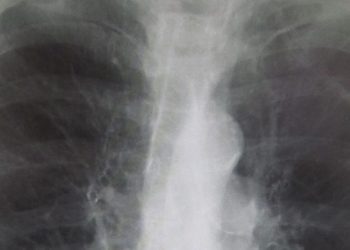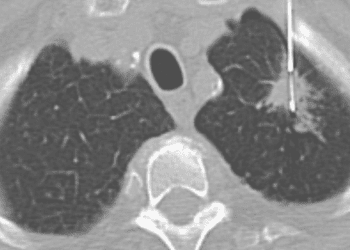Novel trial design establishes clinical effectiveness of fluticasone furoate-vilanter in COPD: The Salford Lung Study
1. A once-daily treatment of combined fluticasone furoate-vilanterol was associated with a significantly lower rate of exacerbations than usual care in patients with chronic obstructive pulmonary disease (COPD), without an increased risk of serious adverse events.
2. The trial used novel methodology to challenge the applicability of results in traditional efficacy studies for clinical practice.
Evidence Rating Level: 1 (Excellent)
Study Rundown: The accepted standard management of COPD using inhaled bronchodilators with or without glucocorticoids is based on effectiveness as demonstrated through numerous randomized controlled trials. However, these trials use strict enrollment criteria and compare treatment to placebo or a specific medication. This questions whether the results are generalizable to clinical practice, as it represents a minority of typical COPD patients. This trial used real-world randomization to evaluate the efficacy of fluticasone furoate-vilanterol compared to the wide range of medications used in usual care. The primary outcome – the rate of moderate or severe exacerbations – was found to be significantly lower in the fluticasone furoate-vilanterol group. Results of secondary outcomes indicated no significant difference in the rate of first exacerbation, annual contact with primary care, or serious adverse events.
This was an open-label, randomized trial that used a large number of patients and simulated the clinical setting. This may better reflect factors that impact COPD management outcomes, such as the result of once-daily administration on drug compliance and tolerability.
Click to read the study, published today in NEJM
In-Depth [randomized controlled trial]: In this open-label, parallel group trial, 2799 patients were recruited from 75 general practitioner (GP) practices in the United Kingdom. Patients were randomized to treatment with either fluticasone furoate-vilanterol (n=1291) or usual care (n=1309), which included the array of medications normally chosen by the GP. The primary outcome of interest was the rate of moderate to severe exacerbations, analyzed in the trial population that had an exacerbation in the previous year and in the total trial population. Secondary outcomes were analyzed based only on the entire trial population and included the rate of first exacerbation, annual rates of primary care contact, and the rate of serious adverse events.In the primary effectiveness analysis population, the rate of moderate or severe exacerbations was 8.4% lower in the fluticasone furoate-vilanterol group (95% CI, 1.1 to 15.2; p=0.02), which was confirmed in the entire trial population. There was no significant difference in the rate of first exacerbation in the time-to-event analysis between treatment groups (HR, 0.93; 95% CI, 0.85 to 1.02). No significant difference was found between the annual rate of COPD-related contact with primary care between groups (1.7% lower in the fluticasone furoate-vilanterol group; 95% CI, -5.1 to 8.0). The incidence of serious adverse events was similar in both groups; however, a trend towards an increased number of cases of pneumonia in the group in the treatment arm without an inhaled glucocorticoid was noted (mean annual rate, 3.01 hospitalizations; 95% CI, 0.97 to 9.33; p=0.10).
Image: PD
©2016 2 Minute Medicine, Inc. All rights reserved. No works may be reproduced without expressed written consent from 2 Minute Medicine, Inc. Inquire about licensing here. No article should be construed as medical advice and is not intended as such by the authors or by 2 Minute Medicine, Inc


![2 Minute Medicine: Pharma Roundup: Price Hikes, Breakthrough Approvals, Legal Showdowns, Biotech Expansion, and Europe’s Pricing Debate [May 12nd, 2025]](https://www.2minutemedicine.com/wp-content/uploads/2025/05/ChatGPT-Image-May-12-2025-at-10_22_23-AM-350x250.png)






